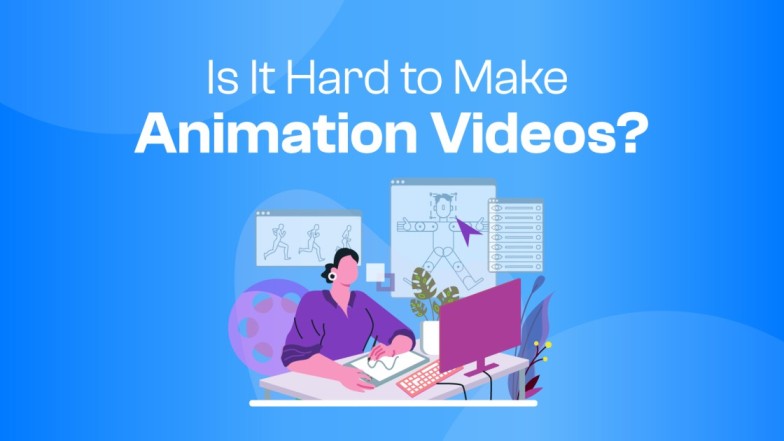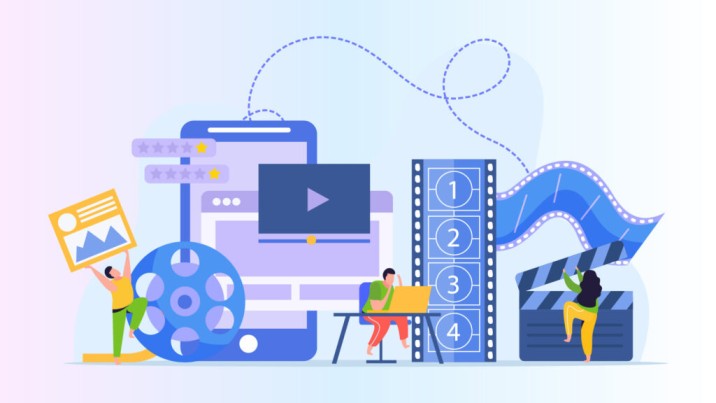
Is It Hard to Make Animation Videos? [Explained Everything]
Have you ever wondered, Is it hard to make animation videos?
Making animated videos can be tricky since it requires technological know-how, imagination, and meticulousness. Animators must be proficient in animation software, know the fundamentals of Animation, and be able to sketch or model complex 3D models.
Animation has long captivated audiences worldwide, enchanting them with captivating characters and immersive storytelling. Yet, behind the scenes lies an intricate process that demands a unique blend of technical expertise and boundless creativity.
In this blog post, we will discuss the fascinating world of animation video creation, the required skills, how to be an animator, and explore the challenges that animators encounter on their creative journey.
What is Video Animation?
Video animation creates moving images or visuals through static images or frames. It is a technique that involves bringing characters, objects, and scenes to life using various software and tools. Video animation can take various forms, such as 2D Animation, 3D Animation, stop-motion animation, or motion graphics.

In video animation, animators use specialized software to manipulate and control images or 3D models, creating the illusion of movement.
They carefully design and time each frame to produce smooth and coherent animations. Video animations are widely used in various industries, including film and television, advertising, gaming, e-learning, marketing, and social media, to convey information, tell stories, entertain, and engage audiences in a visually captivating manner.
Is It Hard To Make Animation Video?
Creating animation videos can be both challenging and rewarding. It requires a combination of technical skills, creativity, and patience. Animators need to master specialized software, understand the principles of Animation, and have strong drawing and illustration abilities. Crafting a compelling storyline and bringing characters to life demands time and dedication.
Moreover, animations can be time-consuming, and attention to detail is crucial to achieve high-quality results.
Despite the challenges, the satisfaction of seeing a captivating animation come to life and the ability to convey complex ideas through visuals make it a fulfilling and exciting endeavor for those passionate about the art of Animation.
2D Animation Vs. 3D Animation: What Is More Complex?
Both 2D Animation and 3D Animation have their complexities, but the level of complexity can vary depending on the specific project and the animators’ skills.
2D Animation Complexity: In 2D Animation, animators work with two-dimensional images and create the illusion of movement through a sequence of frames. It involves drawing characters, backgrounds, and objects on a flat surface.
2D Animation can be more straightforward regarding software and tools, making it more accessible for beginners. However, creating smooth and expressive movements requires a strong understanding of timing, spacing, and drawing techniques.
Complex scenes, such as intricate character movements or hand-drawn special effects, can be time-consuming and challenging to animate.
3D Animation Complexity: 3D Animation involves creating characters, objects, and environments in a three-dimensional digital space. Animators use specialized software to model, rig, and animate 3D assets.
3D Animation can be more technically demanding, requiring 3D modeling, rigging, texturing, lighting, and rendering knowledge. The complexity increases as animators deal with advanced features like physics simulations, cloth dynamics, and complex camera movements.
However, 3D Animation also offers greater realism and depth, making it suitable for creating lifelike characters and intricate environments.
The complexity of both 2D and 3D Animation depends on the scope of the project, the skill level of the animators, and the specific requirements of the Animation. While 3D Animation may involve more technical aspects, 2D Animation demands strong drawing and animation skills.
Ultimately, both forms of Animation require creativity, attention to detail, and dedication to produce high-quality, engaging animations.
Why Making Animation Video So Hard?
Making animation videos can be a challenging process that requires a combination of technical skills, creativity, and attention to detail. Several factors contribute to the complexity of creating animation videos:

Technical Expertise
Animation involves using specialized software and tools requiring a significant learning curve. Animators must be proficient in using software like Adobe After Effects, Autodesk Maya, and Toon Boom Harmony. Understanding the software’s features, controls, and animation techniques is essential for producing high-quality animations.
Artistic Skills
Animators need strong drawing and illustration abilities to create characters, scenes, and backgrounds. Drawing characters consistently and conveying emotions through Animation requires artistic talent and practice. Creating visually appealing and coherent animations demands a keen eye for detail and aesthetics.
Time-Consuming Process
Animation is a time-consuming endeavor. Depending on its complexity and length, creating a short animation video can take days, weeks, or even months. Animators need patience and persistence to work through the meticulous frame-by-frame Animation process.
Attention to Detail
Animators must pay meticulous attention to detail to ensure smooth movements, consistent character designs, and visually appealing scenes. Every frame requires careful consideration, ensuring the Animation flows seamlessly and effectively and conveys the intended message.
Understanding Movement and Timing
Animators need to understand the principles of movement and timing to make animations look realistic and engaging. Concepts like anticipation, squash, stretch, and follow-through are crucial in bringing characters and scenes to life.
Storytelling and Conceptualization
Crafting a compelling storyline and developing characters that resonate with the audience requires creative thinking and storytelling skills. Animators need to communicate ideas and emotions through visuals, making the audience connect with the Animation on an emotional level.
Problem-Solving and Adaptability
Animation projects often present challenges that require problem-solving skills and adaptability. Animators may encounter technical issues, tight deadlines, or changes in project requirements. Adapting and finding creative solutions is essential to keep the project on track.
Collaborative Effort
Animation projects often involve a team of animators, directors, writers, and designers. Effective communication and teamwork are critical to ensure a cohesive and successful outcome. Coordinating with team members, taking feedback, and incorporating changes are essential aspects of the collaborative process.
Soft Skills Needed To Be A Successful Animator
To be a successful animator, possessing a range of soft skills is just as important as technical expertise. These skills complement the creative process and are vital in delivering exceptional animations.
Creativity is an innate quality that animators must have. It enables them to visualize and conceptualize unique ideas, breathe life into characters, and craft engaging narratives that captivate audiences. A strong imagination and the ability to think outside the box are essential in producing innovative and compelling animations.
Practical communication skills are crucial for animators, as they often work in teams and collaborate with various professionals, such as art directors, designers, and writers. Clear communication ensures seamless coordination and understanding between team members, creating a more cohesive end product.
Attention to detail is a fundamental skill for animators. Every frame and movement requires precision, and even the most minor changes can significantly impact the final Animation. Paying close attention to the minutiae ensures that the Animation appears polished and seamless.
Patience is essential in Animation, as it is a time-consuming process that requires dedication and perseverance. Animators may spend hours, days, or weeks working on a single sequence, making minor adjustments to achieve the desired outcome.
Time management is valuable for animators, especially when working on tight deadlines. Being able to prioritize tasks, meet project milestones, and deliver on time is essential to ensure the project’s success and maintain a positive reputation in the industry.
Lastly, adaptability is decisive in the ever-evolving world of Animation. Technology and trends constantly change, and animators must stay updated with the latest tools and techniques. Adaptability allows animators to embrace new challenges, remain competitive, and continue producing cutting-edge animations.
What Hard Skills Are Needed To Be A Animator
To be a successful animator, mastering hard skills is essential. These technical abilities form the foundation of the animation process and enable animators to bring their creative visions to life. Animators must have proficiency in animation software such as Adobe After Effects, Autodesk Maya, Cinema 4D, or Toon Boom Harmony.
These software tools allow animators to create and manipulate characters, scenes, and visual effects, requiring a deep understanding of their features and tools to produce high-quality animations.
Strong drawing and illustration skills are also crucial for animators. Skilled in traditional drawing techniques and digital illustration allows animators to design characters, storyboards, and backgrounds effectively. A keen eye for detail and artistic creativity enables animators to bring characters to life and convey emotions through Animation.
Understanding anatomy and movement is vital for animators to create realistic and fluid animations. Knowing how the human body moves and being able to apply that knowledge to characters and creatures adds authenticity to the animations.
Moreover, having a solid grasp of timing and motion principles is necessary to make animations look believable and visually appealing. Understanding concepts like anticipation, squash, stretch, and follow-through allows animators to create dynamic and engaging animations that resonate with audiences.
In addition to technical skills, problem-solving, and critical thinking are essential for animators. Often faced with complex challenges during Animation, animators must devise creative solutions and make informed decisions to overcome obstacles.
How To Become A Successful Video Animator
Becoming a successful video animator requires technical skills, creativity, and perseverance. If you’re passionate about bringing characters and stories to life through Animation, follow these nine steps to pave your way to success:

Master Animation Software
Learn industry-standard animation software like Adobe After Effects, Autodesk Maya, or Toon Boom Harmony. Take online courses, watch tutorials, and practice regularly to become proficient in using these tools. Familiarize yourself with the software’s features, controls, and animation capabilities. Experiment with different effects and techniques to expand your skill set and enhance your versatility as an animator.
Study Animation Principles
Familiarize yourself with fundamental animation principles, such as timing, spacing, squash and stretch, anticipation, and follow-through. Understanding these principles is crucial for creating believable and captivating animations. Analyze animations from experts in the field and study how they apply these principles to bring characters and scenes to life. Apply these concepts to your work to improve the quality and impact of your animations.
Develop Your Drawing Skills
Even in digital Animation, strong drawing skills are valuable. Practice sketching regularly to improve your understanding of anatomy, character design, and storytelling through visuals. Drawing enhances your ability to create appealing characters and helps with storyboarding and planning your animations. Consider taking life drawing classes or attending figure drawing sessions to sharpen your skills and observe real-life movements and expressions.
Build a Diverse Portfolio
Create a portfolio showcasing a variety of animation styles and techniques. Include character animations, motion graphics, and any other type of animations you’ve worked on. Your portfolio should highlight your ability to tell stories through Animation, your range as an animator, and your attention to detail. Regularly update your portfolio with new and improved work to demonstrate your growth and development as an animator.
Collaborate and Seek Feedback
Engage with fellow animators and seek opportunities for collaboration. Working with others on projects allows you to learn from different perspectives and gain valuable experience in a team setting. Additionally, seek feedback from industry professionals and peers to identify areas of improvement and refine your skills.
Stay Updated with Trends
Keep yourself updated with the latest trends, techniques, and technologies in the animation industry. Follow industry blogs, attend animation conferences and workshops, and participate in online communities to stay informed about emerging tools and practices. Staying current will make you more relevant and adaptable in a rapidly evolving industry.
Be Open to Learning
Animation is a continuous learning process. Embrace new challenges and be open to learning new skills. Stay curious and experiment with different styles and approaches to Animation. Continuously seek ways to expand your knowledge and improve your craft.
Network and Market Yourself
Building a solid professional network is essential in the animation industry. Attend animation events, join online forums, and connect with professionals on social media platforms like LinkedIn. Networking can lead to job opportunities and collaborations. Additionally, create a professional online presence by showcasing your work on social media and professional websites to increase your visibility and attract potential clients or employers.
Be Persistent and Patient
Becoming a successful video animator takes time and perseverance. Stay committed to your passion for Animation, and be patient with your progress. Celebrate your successes, learn from your failures, and use setbacks as opportunities for growth. The animation industry can be competitive, but with dedication, hard work, and a willingness to learn, you can carve a rewarding and successful career as a video animator.
How Competitive Is The Job Market For Animators?
The job market for animators can be highly competitive due to the increasing demand for animated content in various industries, including film, television, gaming, advertising, and digital media. The rise of streaming platforms, online content creation, and virtual reality has further fueled the demand for skilled animators.

However, the industry attracts many aspiring animators, making it competitive for job seekers. To stand out, animators need a strong portfolio showcasing their skills, versatility, and creativity. Continuous improvement, staying updated with the latest animation trends and software, and networking within the industry can enhance job prospects in this competitive field.
Frequently Asked Question
Is It Hard To Make Animation Videos?
Creating animation videos can be challenging, involving technical skills, creativity, and attention to detail. Animators must master animation software, understand animation principles, and possess strong drawing or 3D modeling skills.
Do I Need Artistic Talent To Make Animation Videos?
While artistic talent can be beneficial, it is not the only requirement for making animation videos. Technical skills and knowledge of animation principles are equally important. With practice and dedication, animators can develop their artistic abilities.
How Long Does It Take To Create An Animation Video?
The time required to make an animation video varies depending on its complexity and length. Simple animations can be completed relatively quickly, while more intricate projects may take weeks or months.
Do I Need Expensive Software To Create Animation Videos?
Various animation software options are available, including free and paid versions. While some professional-grade software can be expensive, there are affordable alternatives with robust features for animators on a budget.
Can I Create Animation Videos Independently, Or Do I Need A Team?
Animators can create animation videos individually, especially for small projects. However, more extensive or complex animations often require a team, including animators, storyboard artists, voice actors, and sound designers.
Is It Worth The Effort To Make Animation Videos?
Yes, making animation videos can be enriching. The ability to bring stories and ideas to life through Animation offers a unique and powerful way to communicate with audiences. While it requires effort and dedication, the satisfaction of seeing a completed animation and the positive impact it can have made it worth the investment.
Final Words
Animation video creation can indeed be challenging, but it is a rewarding and fulfilling process. From mastering animation software to honing artistic skills, animators embark on a journey of creativity and technical excellence.
While it may require time, effort, and dedication, the ability to bring imagination to life through Animation is unparalleled.
So, if you wonder, “Is it hard to make animation video?” remember that with passion, perseverance, and continuous learning, animators can overcome the hurdles and create captivating animations that impact audiences worldwide. Embrace the challenge, and let your creativity soar as you venture into the exciting world of Animation!
Read More Similar Posts:

















































